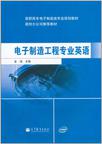电子制造工程专业英语
出版时间:2011-8 出版社:高等教育出版社 作者:金鸿 编 页数:143
内容概要
《高职高专电子制造专业规划教材:电子制造工程专业英语》旨在使读者掌握电子制造工程专业群的英语术语及用法,培养和提高读者阅读和翻译专业英语文献资料的能力,为今后获取和交流专业技术信息打下良好的基础。全书共18课,内容包括电的本质、电场、简单电路、半导体材料、电化学基础、光化学基础、电子封装、印制电路板成像、电镀技术、柔性电路、柔性电路的检测、显示技术简介、液晶显示、等离子显示、发光二极管、半导体器件及集成电路、半导体制造工艺、封装及测试等。每课由课文、语法(或翻译或应用文)和扩展阅读组成。本书还简单介绍了翻译知识,并配有适量的练习与扩展阅读材料,供教师选用及学生自学用。 《高职高专电子制造专业规划教材:电子制造工程专业英语》内容新颖,图文并茂,浅显易学,可用作光电子技术、电子电路设计与工艺、微电子技术、光伏发电技术及应用等专业的专业英语教材或教学参考书,也可供从事电子制造工程类专业的工程技术人员学习参考。
书籍目录
Lesson OnePart I Intensive Reading: The Nature of ElectricityPart II Grammar: Parts of SpeechPart III Extensive Reading: Why do We Get a Shock from Electricity?Lesson TwoPart I Intensive Reading: Electric Field, Potential and VoltagePart ]] Grammar: Prefix and SuffixPart III Extensive Reading: Electric Field and Electric Field LinesLesson ThreePart I Intensive Reading: Simple Electric CircuitPart II Grammar: Word-FormationPart III Extensive Reading: DC Biasing——BJTsLesson FourPart I Intensive Reading: Semiconductor MaterialPart II Grammar: Word-activityPart III Extensive Reading: Growth of Semiconductor MaterialsLesson FivePart I Intensive Reading: Electrochemistry BasisPart II Grammar: Sentence BackbonesPart III Extensive Reading: The History of ElectrochemistryLesson SixPart I Intensive Reading: Photochemistry BasisPart II Grammar : Sentence ElementsPart 1II Extensive Reading: Photolithography IntroductionLesson SevenPart I Intensive Reading: Electronic Package and High-density InterconnectivityPart II Grammar: Complex Sentence IPart III Extensive Reading: Electronic PackagingLesson EightPart I Intensive Reading: Printed Circuit Board ImagingPart II Grammar: Complex sentence IIPart III Extensive Reading: HannStar Board-GBM Consolidation to Create Largest PCB Maker in Taiwan ProvinceLesson NinePart I Intensive Reading : Plated-Through-Hole(PTH) TechnologyPart II Translation Skills: Translation Standards and ProcessPart III Extensive Reading: The Disadvantages of Pattern PlatingLesson TenPart I Intensive Reading: Flexible CircuitsPart II Translation Skills: Conversion of Part of SpeechPart III Extensive Reading: Design of Flexible CircuitsLesson ElevenPart I Intensive Reading: Inspection and Test of Flexible CircuitsPart I1 Translation Skills: Translation of Complex Sentences in Scientific EnglishPart III Extensive Reading: Printed Electronics Make PCB “Green Up”Lesson TwelvePart I Intensive Reading: Introduction of Display TechnologyPart II Translation Skills: Amplification and DeletionPart II Extensive Reading: Flat Panel Buying TipsLesson ThirteenPart I Intensive Reading: Liquid Crystal DisplayPart II Practical Writing: ResumePart III Extensive Reading: High Luminance and Wide Color Gamut——for clear, vivid colorLesson FourteenPart I Intensive Reading: Plasma Display PanelPart II Practical Writing: Cover LetterPart III Extensive Reading: Full HD Plasma Pane! Creates a True Full HD 3D WorldLesson FifteenPart I Intensive Reading: Light Emitting DiodesPart II Practical Writing: Reference LetterPart III Extensive Reading: Organic Light Emitting DiodesLesson SixteenPart I Intensive Reading: Semiconductor Devices and Integrated CircuitsPart II Practical Writing : AdvertisementPart III Extensive Reading: How Solar Cells Work?Lesson SeventeenPart | Intensive Reading: Semiconductor Manufacturing ProcessesPart II Practical Writing: Self-IntroductionPart III Extensive Reading : PhotolithographyLesson EighteenPart I Intensive Reading: Packaging and TestingPart I1 Practical Writing : Work ReportPart III Extensive Reading: Chip Scale PackageReference
章节摘录
Electricity shocks us, because it is an outside force that interferes with the internal electricity our bodies' nervous systems generate. To fully understand why the chance of encountering these two electrical forces results in a shock to our systems, we must first understand the fundamentals of electricity itself. In scientific terms, electricity is considered a fundamental force, one that is extremely basic, and has been in existence since the beginning of time. Further simplified, it is so basic, that it defies explanation, and is Mother Nature's way of saying “Because I said so !” Electricity comprises positive and negative charges, opposite charges attract each other, and similar charges repel each other. Those charges attracted to each other can be separated, with the end pr duct being potential energy, that is, energy that will be released as voltage, should the two reunite. We pay electric companies to separate the positive and negative charges for us, so that we can have electrical energy at our disposal. In order for the charges to reunite, and for the potential energy to be released as voltage, a conductor, a channel that they can flow through, is needed. Insulators, such as paper and glass make poor conductors, while wire and water make excellent conductors. Unfortunately, since the human body consists primarily of water, it too provides a superb conductor for electrical energy, or voltage. If, by chance, outside electrical energy enters our bodies, now conductors, we will be shocked when the voltage encounters, and interferes with, the internal electrical energy our nervous systems produce. The shocks to our bodies, and the amount of damage the electricity does to them, depends on the voltage our bodies are subjected to, on its level of energy, and on how much our bodies resist the flow of the electrical energy. When we are shocked, a variety of things may occur, none of which is desirable. Our muscles may twitch, we may experience problems in the nerve centers that control our breathing, or we may experience problems with our heart rhythms. The worst case scenario from being shocked is death. ……
图书封面
评论、评分、阅读与下载
